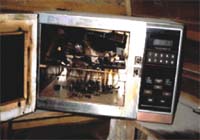Reprinted with permission from Modern Woodworking Magazine.
by Dr. Fred M. Lamb

Get that microwave out of the kitchen and put it to use where calories don’t count but improving wood utilization does. Sample drying in a microwave will save you time and ultimately could save you money.
The most accurate way of determining the moisture content of wood is by the oven-dry method. However, a conventional drying oven takes a considerable amount of time. In general, standard-sized moisture sections (that is, full width, full thickness and one inch along the grain of the board) of green red oak would take at least 24 hours, depending on the quality of the oven, the number of samples being dried and their moisture content. A good quality conventional drying oven should have sufficient heat to easily maintain a temperature of about 213 to 215° F and also have fans for forced air circulation. Even then, a small oven jammed full of wet samples still may take more than 24 hours to oven-dry. Low moisture content samples (such as well air-dried) may take about 12 hours or more. These times are only approximations.
It must be remembered that “oven-dry” is not a time period; it means zero moisture content as determined by two successive weighings (a reasonable time apart) showing no change in weight. You need to verify how long it takes your oven to “oven-dry” samples based on their moisture content and the number in the oven at the same time. Failure to properly oven-dry samples generally means that the moisture content calculation will be incorrect. This usually results in non-uniform drying in the kiln and some wet lumber.

Figure 1. A microwave oven damaged by burning wood samples. This is the result of using improper procedures such as drying too long, or “drying until you smell it” or “drying until it smokes.”
The major advantage of using a microwave oven is the ability to determine the moisture content in about 30 minutes. The major disadvantage is that this procedure is more demanding, requiring high accuracy and attention to the details. It is also much less forgiving of mistakes or poor practices. Some would say that the process is too much of a “hassle.” That may or may not be true, but that is the price of getting an oven-dry moisture content in 30 minutes rather than 24 or more hours for green wood.
Note: Because of the long drying times in a conventional drying oven, many operators cut a thin moisture section rather than the standard one-inch sample. (The thinner samples dry faster.) However, the thinner samples have a greater risk of errors due to a dull saw creating heat and prematurely drying the sample. Also, the time between sawing the sample and weighing it is more critical for thinner samples.
Some operators use a mix of both systems. They microwave the sample to remove a significant amount of the water and then finish it up in a conventional oven. If done right, the sample can be oven-dried by the next morning.
The following are the recommended procedures for using a microwave oven to oven-dry wood samples.
Procedures for oven-drying wood in a microwave oven
Features Required in the Microwave Oven
1. Carousel tray (turn table)
2. Multiple power settings (minimum of three settings, five is even better)
Procedures
1. Weigh the samples
2. Place samples only on the outer edge of the carousel tray, with towel paper on the tray under the samples. Do not over-fill the tray.
3. Do not allow the samples to touch each other.
4. Use a low or low medium power setting.
5a. For well air-dried or kiln-dried wood: Dry the samples in the oven for about three to five minutes.
5b. For green wood: Dry the samples in the oven for about 10 to 15 minutes.
6. Re-weigh the samples.
7. Dry the samples for about one minute or less.
8. Re-weigh the samples.
Continue steps 7 and 8 until no appreciable change in weight (no change in the tenths of a gram).
User Beware
1. A carousel tray is required because the energy distribution in the microwave oven is not uniform.
2. The paper towel is used to carry away any condensed moisture from under the sample.
3. If the samples touch each other, they have the risk of concentrating the energy and causing smoking or burning.
4. A low power setting allows the internal heat in the samples to dissipate. Higher power settings increase the risk of heat build-up and thus the risk of internal charring, smoke and even ignition.
5. Power and time are inter-related. The higher the power, the less the time, the lower the power, the longer the drying time. However, higher power also brings the risk of internal heat build-up (number 4 above). Figure 1 is an example of what can happen when proper procedures are not followed.
6. Both power and time are dependent on the amount of wood in the oven and its moisture content. One sample in an oven is different than having five samples in an oven at the same moisture content. A kiln-dried sample in the oven is different than having a green (wet) sample in the oven. It is best to keep the power constant (at a low setting) and vary the drying times, both the initial drying time and the number and duration of the subsequent time intervals.
7. If the sample starts to smoke, it is damaged and cannot be used to determine moisture content. Obviously, this is also true if the sample is charred (internally or externally) or burnt.
8. Removing the last small amounts of moisture from the samples requires patience and careful monitoring. Do not rush the procedures by using long times in the oven. Better to use many shorter times than fewer, longer times.
9. Samples for moisture content determinations should be cut full width and full thickness of the boards, and one inch along the grain.
10. Do not use generic times; establish drying times for each microwave oven, species, thickness, and moisture content range used.
11. Weigh all samples to the nearest 0.01 grams.
12. Oven-dry means constant weight, that is, no weight loss between subsequent weighings. Practically, samples can be considered oven-dry if between weighings, the change in weight is 0.1 gram or less for a 100 gram or more sample. The error in moisture content can be estimated as follows: for a 125- gram sample, a 0.5-gram error in weight will cause about a 0.4 percent error in the moisture content determination. The level of accuracy needed can be chosen from such an estimate.
Be careful in removing samples from the oven, they can be hot and can cause burns.
Be careful about drying times in the microwave oven. Too long a time can cause the sample to ignite and cause a fire in the oven (Figure 1). Also, be careful about disposal of the samples. If any of the samples have internal charring, it can start a fire in waste cans, trash disposal containers, or wherever it is thrown.
Fred M. Lamb is Professor and Extension Specialist, Department of Wood Science and Forest Products, Brooks Forest Products Center, Virginia Tech, Blacksburg, Virginia. Dr. Lamb can be contacted at 540-231-7256; Fax: 540-231-8868
Reprinted with permission from Modern Woodworking Magazine. Free subscriptions are available by completing an on-line Subscription Form.